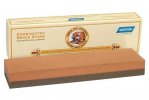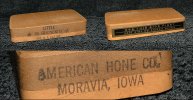- Joined
- Feb 24, 2023
- Messages
- 45
Can anyone help identify what type of stone this might be, and approximate grit types?
It's a combination whetstone, about 5"x3". The coarser side is a medium gray, and the fine side is a light yellowish brown. The fine side has hairline fractures all over, but feels smooth.
Both sides are a lot finer than my Norton combination synthetic India stone.
The stone and leatherette case are stamped "Odell's American Beauty" so I guess it was sold for straight razors. I imagine this would have been used with oil? Based on the font and case material I'm guessing it's from the 1950s-1960s.
I sharpened a dull kitchen knife on these, after setting the bevel with my Norton Combination India stone (150 and 400 grit?), and it came out great.
(both sides were somewhat dished; I started flattening with my coarse diamond plate, but didn't finish. You can see the moon-shaped marks in the first image)



It's a combination whetstone, about 5"x3". The coarser side is a medium gray, and the fine side is a light yellowish brown. The fine side has hairline fractures all over, but feels smooth.
Both sides are a lot finer than my Norton combination synthetic India stone.
The stone and leatherette case are stamped "Odell's American Beauty" so I guess it was sold for straight razors. I imagine this would have been used with oil? Based on the font and case material I'm guessing it's from the 1950s-1960s.
I sharpened a dull kitchen knife on these, after setting the bevel with my Norton Combination India stone (150 and 400 grit?), and it came out great.
(both sides were somewhat dished; I started flattening with my coarse diamond plate, but didn't finish. You can see the moon-shaped marks in the first image)









